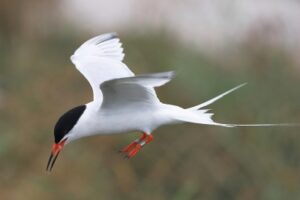(by Diane De Luca)
July 28, 2001 – Journal Entry: I sit in a well-weathered blind atop a rocky knoll with my eyes glued to the first Roseate Tern nest on these islands out at the Isles of Shoals in more than 50 years. It is a spectacular day on the coast, with crystal clear blue skies that allow a seemingly never-ending view of the distant horizon.
Two Roseate Terns seem intertwined with each other. The female is tight in the nest cup and the male lays his bill across her back. He almost seems to caress her and I keep reminding myself that I am watching a pair of birds…but the tenderness is unmistakable.
Something spooks the terns momentarily and the pair is up and off the nest. For the first time, I can see the egg. It appears to be moving, and I readjust my view through the scope. No mistaking…the egg is open and movement real. The adults are back as quickly as they had flown. They settle on the nest and begin to actively rearrange the contents. Both adults reach into the nest with their long, dark bills, gently edging the material.

In another moment, the female stands as she works to settle on the nest cup, she appears fretful and attentive at the same time. She fluffs her feathers and probes with her bill repeatedly. As she stands one more time, I am able to clearly see a tiny wet head. Roseate Tern hatch! For the first time in half a century, Roseate terns are again breeding in New Hampshire. I am bursting with excitement and can barely sit, as I so much want to share the news.
November, 2023 – Reflection: For more than 50 years, the historic breeding grounds of the state endangered Common Tern, the federally endangered Roseate Tern and small numbers of the state threatened Arctic Tern were taken over by the larger, predatory Great Black-backed and Herring Gulls. The gulls nested early in the season and outcompeted the terns for nesting sites as well as preying on these smaller shorebirds.
In 1997, New Hampshire Audubon, in partnership with the New Hampshire Fish and Game Nongame Program and with support from the Office of State Planning Coastal Program, the NH State Parks Division, USDA Animal Damage Control, Shoals Marine Laboratory, Isles of Shoals Steamship Company, Gulf of Maine Seabird Working Group, and the US Fish and Wildlife Service, worked cooperatively to successfully complete the first year of this project by using nonlethal means of gull control along with decoys and tern colony sounds to attract breeding terns back to the Isles of Shoals. A small colony of six pairs of Common Terns raised and fledged six young at this site in the first year. This was the first documented breeding by terns at the Isles of Shoals since the early 1950’s.
Roseate Terns in the U.S. almost always nest in colonies with Common Terns. Since Roseates are less defensive of their nests and young than other terns, they often rely on the Common Terns in the surrounding colony to defend them. Roseate Terns are skittish and will readily abandon eggs and chicks if approached too closely or too frequently. In 1987, the northeast U.S. population of the tern was listed as endangered under the ESA; the remainder of the Roseate Tern population in the Western Hemisphere is listed as threatened.
Since the tenacity of the first six pairs of Common Terns on Seavey Island back in 1997, this colony has continued to grow. Tern biologists from Shoals Marine Lab and NH Fish and Game remain on the island during the breeding season to protect, monitor, and research the workings of the colony. In 2023, the White and Seavey Island tern colony numbered well over 3,500 pairs of Common Terns and 120 pairs of the federally endangered Roseate Tern – one of the largest tern colonies in the Gulf of Maine!
